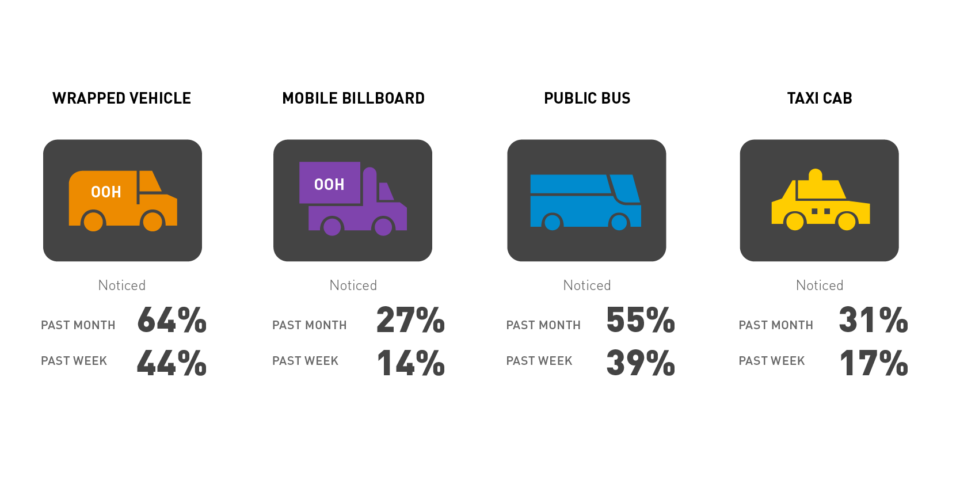Out Of Home marketing, or OOH, has become a staple in every marketing mix, and Nielsen’s marketing research reports have likewise become a vital resource for monitoring the success of various marketing platforms within the industry.
So when Nielsen publishes a report about audience engagement with out-of-home advertising platforms, everyone sits up and pays attention to what it says.
The report, released in 2019, was based on almost a thousand responses from a wide range of people age 16 and over, all across the US, who had taken some form of transport in the past month.
There are 4 established types of OOH ads
Many people still ask, “What is out-of-home advertising?”
Nielsen says… OOH advertising is an offline form of advertising that uses available surfaces in everyday life to send a message. Out-of-home advertising examples are grouped roughly into four categories. They include billboards as the most obvious format. Billboards have been around for decades and have been digitized for decades in urban spaces as well. There are three other categories of OOH. Street furniture, like bus shelters and rubbish bins with graphics on the sides, inhabit every city in the world. Shopping malls have spaces reserved for creative OOH expressions such as flooring mats with ad messages. Lately, it has become more popular to wrap vehicles with printed graphics, which are categorized as transit ads.
These messages are either static, such as billboards, or dynamic, such as wrapped vehicles, but their one defining characteristic is they are in the public space, where people move around in the course of their everyday lives. Traditional advertising platforms required audiences to access them actively by either turning on an appliance (computer, television, or radio) or buying the medium outright (newspapers and magazines).
Certain ads are noticed more than others
OOH messages are difficult to miss because they are in public spaces where masses of people move every day. Therefore, the opportunity for audiences to see and engage with these messages is far greater than on any other platform!
In even better news, the respondents of Nielsen’s survey reported that they noticed these advertisements, some even more than others.

Nielsen says… wrapped vehicles were the most noticed ad type in the transit media category – delivering recall percentages well beyond the other types. So what does that mean for advertisers using this type of OOH medium? The more your out-of-home message is noticed, the more likely you are to see the result you’re aiming for. For example, after seeing a wrapped vehicle for a movie, almost a third of respondents reported going to see that film. These actions also relate to visiting restaurants or stores, attending a sporting event or concert, and tuning into a radio or television program.
Other actions audiences took after engaging with an OOH message include passing on the message via word of mouth, making a phone call, and going online to engage further using a different platform. Word of mouth is recognized as the most authentic form of advertising. Audiences place more trust in what their friends and family say about a product than what an advert says about the same product. Therefore, this combination of OOH and word of mouth is a winner, and it happens organically.
You can see how OOH can drive in-store foot traffic through this process, starting with message engagement, progressing to a follow-up action, and resulting in sales.
Shopping patterns make a difference
Nielsen says… most people do their shopping either after work or on their days off, and when they shop online, they do so mainly from the comfort of their homes. This only accounts for one-third of consumers, though. The other two-thirds prefer to do their shopping in-store.
This indicates messages can influence consumers whilst en route to their shopping destinations. Consider that foremost in people’s minds as they are traveling are topics like family, finances, social plans, and health. This data links up with the industries that have increased their OOH spending; namely Fintech, media, entertainment and hospitality, insurance and real estate, sports, and education.
This is an indication consumers are finding connections. These connections are between their primary personal concerns whilst traveling, and the messages they engage with from OOH media. A marketing campaign that uses OOH can leverage this as a passive primary contact, and then reinforce and build the message on other platforms.
Post-COVID numbers in OOH
Let’s take a look at some more recent post-COVID numbers for comparison. These come from the Out Of Home Advertising Association of America (OAAA) in a report released for Q1 of 2022. They give us a comparative insight into how the various sectors of out-of-home performed, according to the data gathered by the OAAA.
When compared to Q1 of 2021, the following points stood out with respect to the various categories of OOH advertising:
- Digital Out Of Home increased 57%.
- Cannabis spending increased by 31% percent.
- Political spending jumped 113% (and 90% over the last midterm election cycle in Q1 2018).
- Sports betting spending rose 131%.
- Fintech spending increased 22 times.
Among the top ten industries which spent the most on OOH were the above industries. Additionally, media, restaurants, public transport, hotels and resorts, insurance and real estate services, automotive, and schools also featured strongly.
These numbers tell us the big players in the ad industry believe out-of-home digital advertising has become a large and important element within the marketing mix because they are putting more of their money into that option.
We can also see certain markets believe OOH is a more effective platform to reach audiences, namely those in the Fintech, sports, political, and cannabis industries, and it is becoming more popular with a number of key industries as a means of communication, namely the media, automotive, and educational sectors. These are very broad categories with reach into aspects of every person’s everyday life, indicating OOH is a growing platform that is earning player confidence by producing reliable results.
TL;DR
- OOH ads offer a versatile and flexible creative platform for impactful messages.
- Wrapped vehicles are the most noticed medium on the road.
- Most audiences will engage with OOH messaging on some level.
- Most audiences will convert this engagement into actions resulting in purchases or other forms of desired consumer behavior.
